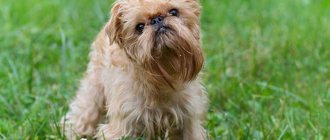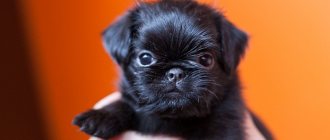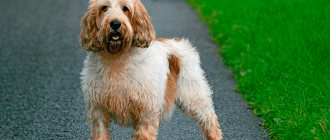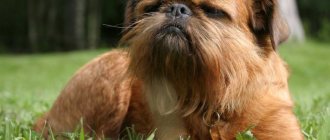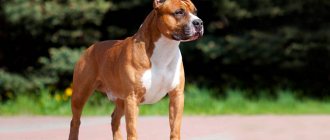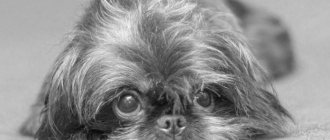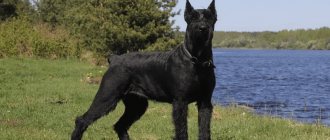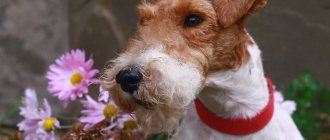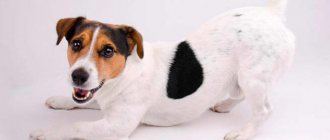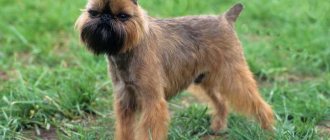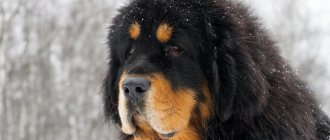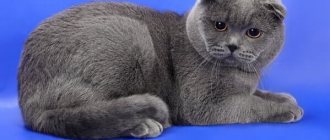Content
Small decorative dogs will feel great in apartments of any size.
Of course, the dog should have its own place with a bed and toys. They get along well with other animals, even with cats, if they don’t mind their company. Sometimes griffons are jealous if they see that their owner devotes less time to them than to other pets. Dogs get along well with children, but with older ones. It’s hard to explain to a small child that you need to be very careful with a miniature griffon. We can recommend this dog breed to anyone who needs a small, playful and loyal companion. The dogs do not require complex care and are perfect even for beginners, and their cheerful disposition will fit perfectly into a family with small children.
Diet
Typically, griffons are fed dry ready-made food, which is selected taking into account the age and physiological condition of the dog. If desired, you can organize feeding with natural products. Griffons are not picky when it comes to food, they love to eat, they are not prone to being overweight, but they have no need to overeat. If you prefer ready-made food, it is better to use high-quality holistic food or at least super-premium food.
Nutrition
Brussels Griffons can even be called voracious dogs that can gain excess weight very quickly. This makes them look like small barrels. Therefore, in addition to proper education and keeping the coat neat, the owner must carefully monitor the diet of his pet. Veterinarians advise buying ready-made food.
It is balanced and specially designed for small breed dogs that lead an active lifestyle. It is better not to save on this and give preference to more expensive brands, as this can accurately guarantee the quality of the chosen food.
The Brussels Griffon puppy to the culture of feeding and feeding by the hour from childhood. Since this breed is very prone to obesity, they cannot be left with food in reserve. It should be poured in portions 2 times a day. Owners should not overdo it with treats, as the griffin can eat them in unlimited quantities.
Dogs of this breed have a fluffy face and after eating, food residues may remain on the fur. Therefore, it is best to wash them or wipe their faces with a napkin after a meal. This will help keep your pet clean and prevent infection from developing.
If the owner is against food, then he can feed the dog regular food. But he must ensure that all useful substances, microelements and vitamins are present in the diet. It is better to add a special complex of vitamins to your food.
Brussels Griffon puppies
Griffon dog. Description, features, care and price of a griffin dog
About half a century ago, people learned about a wonderful creature with the interesting name Griffon dog. They can be seen on the canvases of painters living in the 15th century. Most often they allowed themselves such luxury in non-poor houses.
The Griffon dog breed has always been considered a lady's dog. In addition to the fact that they were used as beautiful and kind friends, they also helped perfectly in the fight against rodents.
This animal was first spotted in 1880. And 1883 was remembered for the fact that griffons were officially recognized as a breed. This event happened in Belgium. The popularity of this breed is undeniable, both in the past and in the present life.
There are three types of them in nature - Belgian Griffon, Brussels Griffon and Smooth-haired. They are all very similar to each other. The only differences are their color and the quality of their fur.
Pictured is a Brussels Griffon
It is impossible to look at the photo of a griffin without delight and tenderness. They are relatively small. An adult dog has an average height at the withers of about 20 cm. And its weight is no more than 5 kg.
The brightest and most basic thing about this animal has always been its head. It is much larger than it should be when compared to the body. And the dog’s face with slightly bulging eyes and a clearly visible black nose reminds everyone of a playful brownie.
Her lower jaw protrudes slightly, giving her a stern appearance. And the mouth is tightly closed, so much so that the teeth and tongue are not visible at all. The ears are normal and medium in size. It used to be fashionable to cut them, but now it is a thing of the past. They are placed high and hang down neatly. The tail is also set high. He has also been docked before.
Belgian Griffon
But today such a griffon tail is a big disadvantage for a dog; one can argue that it is a disadvantage. The animal's paws are strong and have small feet.
The wool is quite hard, and all representatives of the griffins have this quality of wool. The Brussels Griffon dog has a strictly red color. It is this quality that distinguishes her from all other brothers.
The Belgian Griffon dog is always black or close to black. The texture of his fur is the same as that of others. She is hard with extra undercoat.
The Griffon Brabançon dog comes in a variety of colors. But she cannot be confused with anyone because of her smooth fur. She also does not have the naughty goatee that other representatives of this breed have.
In the photo there is a Griffon Brabançon dog
But instead, nature endowed her with long hair around the eyes. This gives her a flirty look. Therefore, the smooth-haired griffon dog looks less angry and intimidating.
Everyone knows that this breed of dog does not have aggression. They have great love and affection for their owner, and are friendly and sociable with other pets.
They need constant communication. Loneliness is a burden for these dogs. They often exhibit a leadership streak. It has been noticed that from too much love and care from the owner, a griffon can turn into a small, capricious and self-satisfied dog.
In order to spoil the Griffon Petit Brabançon dog, you need to make maximum efforts, because in fact, this is a very docile and obedient type of dog.
In the photo there is a dog Griffon Petit Brabançon
Things are a little more complicated with the Belgian and Brussels Griffon. They have a more mischievous disposition. In relation to them, it is better to show toughness of character and have a firm hand.
All types of griffons have amazingly high intelligence and excellent intelligence. Without exception, these dogs remember and carry out all commands with amazing speed.
They love children madly. Playing with a child can take more than one hour. Griffons also perfectly protect their owner and his home, emitting such a bark that it is impossible not to hear. By the way, they don’t bark in vain.
Character of the Brussels Griffon
Representatives of the breed look like stern and unsociable bearded men, but upon closer communication with them it is easy to understand that the first impression is still deceptive.
Brussels Griffons are energetic and sociable dogs that love to be the center of attention. You should be careful with the latter: it’s easy to raise these kids into capricious and demanding pets who won’t leave you alone until they get what they want. Surrounded by love
Owners of griffons refer to their pets as “tails.” Indeed: animals are accustomed to following their owner’s heels and, at the first opportunity, “kissing” him half to death. Four-legged people from Brussels are inclined to support any, even the most extravagant idea. A spontaneous trip to the river bank in the early morning? All paws are in favor! An unexpected trip to the ends of the world? Better! No matter how tired and sleepy the “Brussellian” may be, he will not grumble in response to the offer to actively spend time and will find the strength for a long-awaited walk.
Living in a large family, the griffon considers only one person his equal. The rest will have to try hard to earn at least minimal trust from the dog. And it’s not even worth talking about selfless love: winning the heart of an obstinate baby can take more than one month.
Although Brussels Griffons are self-confident, they need the company of their owner and do not tolerate loneliness well. This breed is not suitable for people who spend a significant part of their time at work. The “Brussellian” will not be the best friend of someone who is not accustomed to obligations to a living being. The animal tends to impose its company, which not every person will like.
There is an opinion among beginners that decorative dogs do not need long walks. This is not the case with the Brussels Griffon: representatives of the breed love to explore their surroundings under the close supervision of their owner. Of course, a half-hour promenade is enough for animals, but if you manage to stay outside as long as possible, your pet’s happiness will know no bounds! It seems that under the fur, which is harsh to the touch, there is a small motor hidden that sets the dog in motion, forcing it to frolic in the fresh air.
Despite its modest dimensions, this breed is famous for its protective qualities. A small “bell” will notify the owner of the approach of an uninvited guest. Of course, you shouldn’t expect zealous protection of property from a griffon, but still rest assured: not even a fly will fly past the vigilant “bearded man” unnoticed.
“Brussels” need early socialization, otherwise the dog will become fearful or aggressive at the sight of strangers. Even properly raised griffons are wary of strangers. A typical representative of the breed will not wag his tail in vain if others sincerely admire him. Instead of barking loudly and joyfully, the animal will growl and take a step back. It is unlikely that a stranger will be able to pet the baby.
Friendship with a cat
Families with children should consider other breeds. Brussels Griffons are not known for their patience with childish games, will not tolerate rough pushing, and may even bare their fangs if they see danger in a child’s actions. In addition, these small dogs are quite fragile and require appropriate treatment. Unfortunately, not all children are careful with pets.
Representatives of this breed easily find a common language with their relatives. If you already had a dog in your house before the Griffon appeared, the Brussels “bearded man” will happily recognize the authority of his older friend and will even begin to copy his habits. However, some kids will still try to take the place of alpha. The owner’s task is to stop possible aggression. This rule also applies to other pets: cats, ornamental rodents and birds. A socialized griffon is tolerant of animals, but in any case will jealously guard its toys and treats.
Brussels Griffons are not suitable for keeping in an aviary - this is a fact. Small pets love a cozy, draft-free apartment. Set up a secluded place for your dog, set aside about an hour and a half for a walk every day, get out of town more often - and the Brussels Griffon will be the happiest!
Belgian Griffon – price and how to buy it correctly
The cost of a Belgian griffon starts from fifteen thousand rubles. It will depend on a number of factors: the seller’s pricing policy, the puppy’s pedigree, its color, gender. Show class puppies will cost more. However, the price of a puppy is far from the first criterion that needs to be taken into account when choosing
It is important to pay attention to a number of more important factors. In particular, to the seller. It’s not worth buying Belgian Griffons secondhand.
It's risky. It’s better to trust a large nursery, although the prices there will be much higher
It is not worth buying Belgian Griffons secondhand. It's risky. It is better to trust a large nursery, although the prices there will be much higher.
You cannot take a puppy based on a photograph. You need to personally visit the breeder to check the conditions in which the puppy grew up. In this case, it is worth examining all the offspring and choosing the most active, beautiful baby. However, it is impossible to predict its future by looking at a puppy's appearance. The baby can still change. Therefore, the second step should be to study the pedigree. In this case, you will be able to understand for yourself what awaits a “Belgian” while growing up.
A good pedigree is an excellent indicator. But it will not mean anything if the baby’s parents are sick. Therefore, you need to make sure about. It is necessary to evaluate not only the physical, but also the mental state of the male and female
When directly choosing a puppy, you need to pay attention to the condition of its teeth, fur, and eyes. The coat should be soft, the teeth should be white and healthy.
There should be no dirt in the corners of the eyes. The puppy should be active and cheerful. If he begins to show aggression, then it is better to refuse to buy such a dog.
How to choose a puppy
- Be responsible when choosing a seller. The Belgian Griffon is a rather rare and capricious breed in terms of breeding, so queues for puppies in nurseries are a common occurrence.
- Try to give preference to breeders who practice line breeding, in which breeding individuals have a common champion ancestor, although they themselves are not closely related.
- Pay special attention to the puppy's exterior. Overly big-headed “Belgians” with an overdeveloped forehead and a miniature body signal genetic mutations in the litter and the presence of the dwarfism gene, which sometimes manifests itself in the breed.
- Even if you don’t plan to conquer exhibitions with your pet in the future, it is better not to take animals with protruding tongues. This is a serious defect in appearance, in the presence of which Belgian Griffons are prohibited from breeding.
- Do not buy the fattest or, on the contrary, the smallest puppy in the litter, giving preference to moderately well-fed middle ones.
- Unfold the Belgian Griffon's coat and evaluate the uniformity of the undercoat, making sure there are no bald spots on the skin.
- Don't be charmed by furry babies with long hair. As they grow older, such hair does not acquire the necessary rigidity, which affects the breed appearance of the griffon.
- The extremely short muzzles of Belgian Griffons only look funny, but in reality they can cause a lot of problems. When choosing between a puppy with a classic brachycephalic type of muzzle and an extremely shortened one, give preference to the first.
Features of intelligence
Belgian Griffons are smart and observant pets. They are easy to train, but upbringing may cause difficulties due to their willfulness and stubbornness.
Belgian training should begin as early as possible so that the pet grows up obedient.
It is worth refraining from too strict training. Ideally, you can turn this process into a game and praise your baby often. Thanks to their intelligence, Griffons quickly adapt to the daily routine at home.
They are ready to do a lot to be praised by their owner. Despite their goodwill, "Belgians" can become jealous of their owner if he gives preference to other family members. But they do not show any aggression towards their opponent.
Representatives of this breed are distinguished by excellent obedience. They love outdoor games and easily learn various tricks.
History of the origin of the species
Griffons cannot be called a new breed; they arose approximately 500-600 years ago. The Belgian appeared a little later than other small dogs, but quickly fell in love with the nobility and, already from the 15th century, showed off at receptions as an accessory for noble ladies. This is evidenced by canvases with portraits of kings and the bourgeoisie: “Cita Arnolfini” and “Portrait of Henry III”.
Most likely, Brussels small dogs and pugs participated in the creation of the Belgian Griffon. Close relatives are also considered Yorkshire Terriers, Affen Pinschers and Kalikov Schnauzers. The very first dog to give birth is considered to be a stray bearded one called “Smoothie”.
In addition to aristocrats, ordinary people also got Belgian small dogs. Griffons have a good sense of smell, hearing and high activity. That is why they were used as mousecatchers in stables and barns.
In 1880, the breed was first demonstrated at the Brussels Exhibition. Breeders became interested in the characteristics of the dog and began actively working on its qualities. After numerous crossings, three species appeared: Belgian, Brussels and Brabant. They differed in the length and density of their fur, the shape of their muzzle and their color.
Oddly enough, the breed has gained popularity in many European countries, except Belgium itself. These dogs were imported to both Italy and France. Belgian Griffons appeared in Russia only towards the end of the 20th century.
The breed was officially registered in 1904. The last amendment to the classification was in 2003. The three breeds are recorded as different species, but the characteristics are the same for all, except for the quality of the coat.
History of the Brussels Griffon breed
Brussels Griffon
Brussels Griffons appeared in Belgium about two centuries ago, although indirect references to the breed date back to the first half of the 15th century. Thus, the “Portrait of the Arnolfini Couple” by the early Netherlandish painter Jan van Eyck depicts a small shaggy dog that looks like a Brussels Griffon. The similarity of the animal with a modern representative of the breed can also be seen in a later painting by the German artist Johann Zoffany. It shows the children of the British King George III playing with light beige dogs that look like griffins. The Frenchman Pierre Auguste Renoir created a masterpiece called “Nude with a Griffon”, where there was also a place for this amazing animal.
Contrary to popular belief, the name of the breed does not come from a mythological creature with the head of an eagle and the body of a lion. The word "griffon" is of French origin and is translated as "wire-haired".
The favorable climatic conditions of Belgium obliged its inhabitants to actively engage in agriculture. Wild rodents, distinguished by their amazing gluttony, became frequent visitors to the barns where grain was stored. After a dozen of their barbaric raids, the Belgians could lose their crops before the onset of winter cold. To successfully combat pests, a new breed was developed - small shaggy dogs that could easily penetrate hard-to-reach places and expel uninvited guests. Outwardly, they differed from modern animals, but the similarities were obvious.
It is worth noting that the breeding program has become quite fruitful, giving the world three varieties of griffons:
- Belgian - direct descendants of Affenpinschers;
- Brussels - a cross between Affenpinschers and Cavalier King Charles Spaniels;
- Brabant (Petit Brabançon) is the result of mating Cavalier King Charles Spaniels and Pugs.
Breeders allow the crossing of three lines with each other. Adult dogs differ only in color and coat type. This is indirectly confirmed by cases of births of representatives of all types of griffons within the same litter.
Petit Brabançon
The fate of the little rat catchers changed dramatically in the second half of the 19th century. Then the griffons attracted the attention of representatives of the nobility. Even the Belgian Queen Marie Henriette admired these dogs. She supported the breeding of animals and played an important role in the spread of the breed throughout Europe. Increasingly, noble ladies accompanied by griffins appeared at dinners and balls. Some used these dogs to guard carriages: the sonorous barking of the kids immediately attracted attention.
There is a well-known story with a sad ending associated with the Brussels Griffons. Thus, Queen Draga of Serbia was obsessed with the idea of poisoning, so before each meal she shared a portion of food with her pet. One day, after taking another bite, the griffon fell to the floor dead. The queen's suspicions were confirmed, but at the same time she lost her faithful pet.
Brussels Griffons were not distinguished by their pretty appearance. Their popularity was due to the enthusiasm of their owners, who appeared at various shows and exhibitions with their shaggy pets. The first appearance of griffins took place in 1880 at an exhibition organized in Brussels. Noticing the public's interest in charming bearded dogs, dog lovers united and founded the Royal Society of St. Hubert in 1882. Soon its members began maintaining the studbook of the breed, which at that time had a different name - the small Belgian wire-haired terrier.
Such an active strategy was crowned with success: already in 1904 the first breed standard was adopted. Six years later, Brussels Griffons were included in the official registry of the American Kennel Club (AKC). In 1920, the Orleans Volcano kennel, owned by Miss Ionides, numbered about 40 representatives of the breed. Most of the dogs were brought from France and Belgium. Ten years later, the woman acquired new griffons from the Nunsoe nursery. With the beginning of the military events of the 20th century, Ionides took care of the export of her charges to Great Britain.
Black Brussels Griffon
Beige Brussels Griffon
In 1926, the first alarm sounded: representatives of the breed were exported less and less from Belgium. After the end of World War II, the number of dogs decreased completely. They mainly lived in the USA and Great Britain, but were much less common in their homeland. In 1945, the first American breed association appeared. After 11 years, Brussels Griffons were recognized by members of the United Kennel Club (UKC). In 1963, breeders finalized the previous standard. It is this version that is still valid today.
Despite the efforts of dog breeders, the breed remained scarce. Thus, during 1993, the French stud book registered only 25 cases of griffon births. Even now, meeting a representative of this breed is a rare success. The Brussels “bearded dogs” have not gained significant popularity, but still have gained the love and admiration of dog handlers around the world due to their extraordinary appearance and good-natured character.
Breed characteristics and character
The Brussels Griffon is a striking example of the terrier, which means that it is completely devoted to its owner. That is, the dog will become a reliable and faithful friend who will accompany the person everywhere.
She will become not just a pet, but also a constant companion who will be very bored if left alone. Therefore, before getting a dog of this breed, you need to be aware that you will need to spend a lot of time with it. And those people who do not have it are better off abandoning this idea.
In order for the Brussels Griffon to feel comfortable and stay healthy, it needs a stable environment. It cannot be said that these dogs belong to the aggressive or fearful breeds.
They, on the contrary, are distinguished by their sensitive nature. In addition, spoiledness will be a distinctive feature. Brussels Griffon dog plays around very quickly
To do this, it is enough to surround her with excessive attention, care and love, and she will not obey her owner
Therefore, those people who live with the Brussels Griffon already know how much attention they need to pay to their pet so that it does not turn into a spoiled and complacent dog. The Griffon is a very friendly dog and gets along well with other pets.
And it doesn’t matter if they are cats or dogs. The griffin will become the central figure of any pet company. At the same time, he is not even embarrassed by his small size, and he tries to take a dominant position over all the residents of the apartment
The Griffon is a very friendly dog and gets along well with other pets. And it doesn’t matter if they are cats or dogs. The griffin will become the central figure of any pet company. At the same time, he is not even embarrassed by his small size, and he tries to take a dominant position over all the residents of the apartment.
Brussels Griffon on a walk in summer
If you properly raise a Brussels Griffon puppy, it will become properly socially adapted. That is, he will not bark and become aggressive at passers-by who decide to pet him or take a closer look at the dog.
If the owner is interested in raising a polite, friendly and obedient dog, then he will begin to socialize and train it from an early age, without giving any concessions. The Brussels Griffon breed is generally characterized as calm. Therefore, she will not bark for no reason day and night or rush at people.
Of course, she will raise her voice in the event of a sudden doorbell or sudden movement from a stranger, but she will not start a confrontation on her own. The Brussels Griffon can be too gluttonous, so they quickly gain weight. The owner must control the quality and quantity of food for the pet.
Brussels Griffon age 1.5 years
These dogs are very difficult to breed. Very often, females require a caesarean section during childbirth. At the same time, a very small litter is born.
Features of the appearance and character of the Belgian Griffons
Today, bearded pets have not lost their popularity and are in great demand among wealthy people. They, together with their owners, go out into the world and take part in cynological exhibitions. Pets with a toy-like appearance at first glance have a strong build and fairly coarse hair.
Breed standard
A true purebred Belgian pet must meet the current standard, which includes a description of appearance and character. Thus, the griffon has the following characteristics:
- the length of the body is equal to the height at the withers;
- fairly large head;
- wide rounded skull;
- a pronounced transition from the forehead to the muzzle;
- prominent forehead;
- The nose is black with wide nostrils, set at eye level;
- the tip of the nose is tilted back;
- short muzzle, not exceeding 1.5 cm in length;
- dense black lips adjacent to each other;
- the lower jaw is wide, curved upward and protrudes beyond the upper;
- the location of the incisors on both jaws is even, parallel, in one line;
- tightly closed mouth;
- large round eyes set wide apart;
- eye color - brown (the darker the better);
- the edges of the eyes are black;
- the ears are small, widely spaced, uncropped ears are semi-erect and hang forward, cropped ears are pointed and erect;
- neck of medium length, smoothly turning into withers;
- withers slightly convex;
- strong, straight, short back;
- short muscular loin;
- wide chest dropped to the elbows;
- well defined groin;
- the stomach is slightly tucked;
- high-set tail, raised upward (the ratio of the length of the docked tail to the natural one is 2:3);
- the tip of the tail is directed towards the back, but does not touch it;
- hind and forelimbs are parallel, with good bones;
- the forelimbs are widely spaced, the hindlimbs are angled in balance with the forelimbs;
- shoulders and knees with normal angles;
- elbows are located close to the body;
- strong wrists;
- hock joint well let down;
- the paws are small, round, the toes fit tightly to each other;
- pads large, black;
- the presence of dewclaws (fifths) on the hind legs is undesirable;
- powerful movements, while running and walking, the paws are parallel;
- the coat has an undercoat;
- the coat is hard, wiry, slightly wavy;
- the muzzle, the area under the eyes, as well as the cheekbones are covered with longer and denser hair than all other parts of the body;
- the longest hair is above the eyebrows;
- coat color: black;
- black and tan, tan markings must be a consistent color and located: on the front legs from paw to wrist;
- on the hind legs - from the paw to the hock;
- may occur on the cheekbones, beard, inner limbs, under the eyes, inside the ear, and around the anus.
Black and tan color is acceptable for Belgian Griffons
Personality of the Belgian pet
The Griffon is an aristocratic dog that has a number of positive qualities. So, she is balanced and always confident. He gets along well with children, but it’s still not worth leaving them alone. A small child can injure a dog.
Griffons are characterized by cheerfulness and enthusiasm. They are brave and loyal to their owner, so they will always come to his defense. This breed is not characterized by a sense of aggression. They behave warily towards strangers and stay away from them. Griffons are very clean dogs, so after eating they will not wipe their faces on their owner’s clothes.
One main disadvantage of this breed is that dogs do not tolerate loneliness, so they are not suitable for people who are often away from home. If the pet feels abandoned and lonely, it will create chaos in the apartment and stop listening and following commands.
Thus, this pet perfectly combines the character traits of a companion and a watchman.
Breed characteristics
| Short description | |
| Origin: | Belgium |
| Conditions of detention: | In an apartment, in a house without a garden |
| Purpose: | Companion dog, rat-catcher dog, decorative dog |
| Color: | Black, charcoal, black-red |
| Wool length: | Average |
| Adult dog size: | Height 26-32 cm, weight approximately 3-6 kg |
| Average life expectancy: | 13-15 years old |
| Walk: | Need a 2-time walk |
| Physical activity needs: | Average physical activity needs (walking 1 to 3 hours per day) |
| Fédération Cynologique Internationale (FIC) classification: | Group 9: Toy and Companion Dogs, Section 3: Small Belgian Dogs |
| Puppy price: | 10000-30000 rubles |
Breed traits
Breed traits (on a 5-point scale)
| Brussels Griffon | |||
| Activity | in the house | 3 | |
| on the street | 3 | ||
| Obedience | training | 3.5 | |
| strangers | 4 | ||
| Domination | in family | 2 | |
| over dogs | 2 | ||
| Defending your territory | from people | 1.8 | |
| from dogs | 2 | ||
| Sociability | in family | 5 | |
| with strangers | 4.5 | ||
| with dogs | 3 | ||
| Concentration | in family | 1 | |
| in front of strangers | 2 | ||
| with dogs | 2 | ||
| Aggressiveness | in family | 1 | |
| to strangers | 1.5 | ||
| to the dogs | 2 | ||
| to cats | 2 | ||
| Family behavior | calmness | 4 | |
| demand for affection | 4 | ||
| excitability | 4 | ||
| playfulness | 3.6 | ||
| excessive barking | 2.7 | ||
| behavioral breakdowns | 1.5 | ||
| Tolerance for children | up to 4 years | 4 | |
| over 4 years old | 3.8 | ||
| Institutional use | watchman | 1 | |
| bodyguard | 1 | ||
This breed is often compared to the following dog breeds: Affenpinscher, Yorkshire Terrier, French Bulldog, Chihuahua, Pug.
The photo shows what Brussels Griffons look like:
What is the difference between griffons?
Both the Brussels Griffon and the Belgian Griffon have a hard coat, but the former representatives of the breed are exclusively red, while the latter are black or black and tan. Brabançon has both red, black, and black and tan colors. There are pets with coats of rich brown, red with hints of black, and mixed shades. Brabançons, according to the standard, can only be smooth-haired.
Since the Griffon is an indoor breed, the character and behavior within the family are very important characteristics of the breed. Breeders talk about a balanced psyche, the absence of excessive aggression or mobility. And this is not at all surprising, since dogs were brought to us from Europe, where quite strict laws were adopted regarding the level of aggression of pets.
Griffons do not rush at people passing by and practically do not pay attention to other animals. If the owner already has “living creatures”, then a small intelligent bearded man will fit perfectly into the general company.
For a large family, you can get any of the griffons, but most often the Petit Brabançon becomes a companion for children's games, and the Brussels and Belgian representatives of the breed prefer to watch the life of their owners from the outside. A great option for older couples or single elderly people.
Griffons do not run away from a leash and are always happy to accompany you on a long walk. They do not bark or sniff those passing by, they keep their pace perfectly and walk next to their owner.
The animal is quite smart, which, given its light and unburdensome nature, can only be considered a plus. They love to sleep in the same bed with their owner or on his lap. The Brussels aristocrat-griffon will not be offended if they cannot devote time to him this very second - he will calmly find something to do or simply go to his place
They love to lie in armchairs, and at the same time they look very important, lying imposingly on the soft upholstery.
Health and life expectancy
In general, this dog, unlike others, is not sickly, has strong immunity and health. Many beginners are interested in: how long do griffon dogs live? The answer will not upset you, since representatives of this breed are long-livers (up to 15 years).
Belgian Griffons sometimes suffer from certain diseases, but with proper treatment they are not life-threatening:
- eye diseases: conjunctivitis, cataracts;
- viral, infectious diseases;
- parasites;
- damage to the kneecaps;
- complicated pregnancy, childbirth.
All dogs are given a vaccine that increases immunity to infectious and viral diseases.
A pet on a walk without vaccination can pick up any infection
Mating
Dogs reach sexual maturity after approximately 1 year of life.
- As a rule, dogs are brought into their third heat. The male must be smaller than the female. In this case, the puppies will not be too huge, and the birth will be successful.
- For the first time, it is better to contact an experienced specialist who will tell you the procedure.
- The dogs are walked together and then taken to the male dog’s place of residence. As a rule, animals have active behavior.
- After two days, mating must be done again.
Note! Griffons really like to play, bark, and dig. They are usually kind to other people and not aggressive at all.
These dogs are considered to be excellent family pets.
Possible diseases
The Brussels Griffon belongs to small breed dogs, so they are characterized by almost all common diseases. The most common diseases are:
- Narrowing of the nostrils.
- Retinal atrophy.
- The presence of additional eyelashes.
- Cataract.
- The eyeball may fall out of the socket.
- Difficulty and problems with childbirth. In almost all cases, you will need the help of a veterinarian and a caesarean section.
- Dropsy of the brain.
- Hip dysplasia.
- Various dislocations. The kneecap is especially often affected.
- Allergy.
Therefore, the owner must closely monitor his pet. It is especially important to maintain a proper diet. If the owner of a griffin notices any deviations in the behavior or health of the dog, he should immediately consult a doctor.
Appearance of Petit Brabançon
Petit Brabançons can be considered an exclusively “ladies’” breed. The reason for this is their small size, which gives the impression that the animal is fragile and weak. In fact, griffons have a strong physique, harmoniously combining a comical face and grace.
The height of adult individuals reaches a maximum of 26 cm, and the weight hardly reaches 5-6 kg (about the same as that of a cat). The breed is not divided into “standard” and “mini”. Therefore, if there are any differences in appearance between individual pets, they are associated solely with genetic characteristics.
Head
In comparison with the miniature body, the head of griffons is quite large. The skull has a wide, rounded shape. The muzzle is short and upturned (largely due to the nose). The breed is distinguished by its emotionality and lively facial expressions (the animal may periodically frown, show surprise or joy).
Teeth
Ideally, the teeth and tongue should not be visible (as the mouth is always closed). The color of the teeth is white, but they are hidden under thick black lips. The lower jaw is wider and protrudes slightly forward.
Eyes
The first thing passers-by and potential owners of Belgian Griffons notice is their large, widely spaced brown eyes. At the edges they have a darker shade, the whites are not visible
Ears
Petit Brabançons have small ears, located at a sufficient distance from each other. And if they are not docked in puppyhood, they will be positioned half-lying, half-standing. Whereas cropped ears have pointed tips and stand straight, without hanging forward at all.
However, the breed standard allows both options. Therefore, if the ears were not cropped on time, it’s okay.
Lips and nose
The lips of Belgian Griffons are completely black, tightly fitting to each other. In this case, the upper one slightly covers the lower one, but does not sag. Otherwise, it will be considered a breed defect.
The nose is located approximately at the same level as the eyes. It is distinguished by its black color and wide nostrils.
Neck
The neck of the Brabançon is of medium length and is in perfect harmony with the shoulders. In this case, no defects are observed (possibly with rare exceptions).
Frame
The length and height of the dog’s body are almost identical. This gives the dog a square shape. The loin is short and slightly arched, the back is strong and straight. The chest bone is quite wide and lowered to the elbows. When viewed from the side, the chest protrudes slightly forward. The Griffon has a tucked belly and a pronounced groin line.
Tail
The Brabançon's tail is carried up, but it is usually docked. If left "original", it will "look" towards the back and be shaped like a saber.
Limbs
They are located parallel to each other, but at the same time widely spaced. The small paws are round in shape, the wrists are quite strong, the thick paw pads have a rigid structure and a dark color (from dark brown to black). The claws are completely black.
Wool
The coat is short and shiny (no more than 2 cm in length). And in the area of the limbs, back and muzzle it is even shorter. Griffon wool has a dense and hard structure.
Color
Petit Brabançons are either completely black in color or have tan or reddish patches. But regardless of the color of the body and limbs, the muzzle should always be dark.
Visual defects that do not affect anything
Smooth-haired griffons may have the following appearance defects:
- Too elongated body.
- Prominent, small, slanted or too light eyes.
- Tail curled into a ring.
- The presence of white hairs in the chest or muzzle area.
- Ears that are too large or round.
- Underweight and, conversely, overweight.
- Underestimated or overestimated growth parameters.
If the above defects are present, the animal is still considered healthy, but due to possible deviations from the standard, it may cost less than usual.
Disqualifying faults
Here is a list of deviations due to which an animal may be disqualified:
- Inappropriate behavior. If a dog behaves too shyly or aggressively, attacking other animals or people, it loses status and is disqualified.
- Pigmentation on the face or nose.
- The tip of the tongue sticking out or the upper jaw protruding too far forward.
- Gray or brown color with tan marks.
- The presence of mental or physical abnormalities.
Character and habits of Belgian Griffons
Belgian Griffons are real livelies! Their breed is highly energetic and active. The character of decorative dogs is calm and balanced. Griffons are very friendly and kind by nature. This dog is often chosen by single people or families with children. A positive character quality is the absence of aggression. Griffons will not rush at passers-by; they are indifferent to other animals. Therefore, during a walk, the Belgian Griffon will not break free from the leash and will behave obediently.
Belgians love their family. They form a very close contact with the owner. They quickly become attached to him and cannot stand long separation. Griffon will try to be closer to his owners even at night - he can sleep with them in the bed or next to it. Such a dog quickly finds a common language with children. He can play with them all day. Only loneliness makes him unhappy. Such a pet should not be left alone for a long time.
Belgian Griffons are very curious and sociable. They love to be the center of attention. This dog will follow his owner everywhere - he will not allow anything to happen in the house without his knowledge. Also a distinctive character trait is a great desire to learn new things. Griffons love to learn and quickly remember new commands. It is a pleasure to train such a dog. The main thing when training is not to express aggression and conduct all classes in a relaxed, playful environment.
Education and training
It is easy to fall under the charm of small Belgian dogs, but do not forget that a spoiled animal, even one as charming as the Belgian Griffon, is a big problem. In addition, at four months of age, tiny “barbels” begin to encroach on the status of leader and try to ignore the master’s authority. At first, such efforts look funny. However, the further a pet goes in its disobedience, the greater discomfort it threatens for a person who is forced to coexist in the same territory with an ill-mannered dog.
Correcting the habits of Belgian Griffons is relatively easy. The breed is distinguished by its intelligence and does not suffer from donkey stubbornness. At 2.5 months, puppies must undergo socialization, that is, learn to calmly accept the touch of their master’s hands, not be afraid of extraneous rustles, and respond to their own nickname. At the same time, it is worth considering that children who have not passed the three-month age limit have a hypersensitive psyche, which slows down the educational process. For this reason, young individuals should not be pressured or shouted at. It is better to stimulate them with a treat as the command is successfully completed.
It’s also not a good idea to demonstrate excessive loyalty, so if you’re not sure that your pet, who is passionate about an interesting activity, will want to hear the demand, you should temporarily pause the lesson. Remember, the command must always be executed. Let it be slow at first and distracted by extraneous factors, but ultimately the goal must be achieved. For this reason, dog handlers strongly advise against repeating demands. The young griffon will quickly realize that the owner is ready to wait, and in the future he will try to respond to commands after he has done more important things, in his opinion.
Teenage griffons are great lovers of food, plus at this age they have an extremely heightened sense of smell. Often driven by gastronomic instincts, “Belgians” resort to begging, but in no case should you be fooled by the animal’s touching, pseudo-hungry glances. Please note that food from your table should not be placed in front of your pet’s nose, otherwise it will be unrealistic to wean him from hypnotizing the gaze of the dining household members. Growling and attempts to bite people are also typical characteristics of the maturing Belgian Griffon. Spontaneous aggression must be stopped sharply and without malice. It is enough to shake a rambunctious dog by the collar or press him to the floor for him to realize that he has overdone it in his dominance.
Conditions of detention
Due to its size, the French Wirehaired Pointer is suitable for any type of home - it can be kept both in an apartment and in a private house. Indoors, the dog will not make noise or bark, but on a walk you cannot do without excitement and loud games. Regardless of the place of residence, the owner must provide the pet with daily activity in the fresh air - he will have to walk with such an energetic dog for at least 2-3 hours, giving him the opportunity to run around to his heart's content. Despite their hunting purpose, wire-haired pointers feel great in city conditions, but when walking, it is better not to let your pet off the leash in an unfenced area - innate instincts can play a cruel joke, and the pet will run away.
The owner of the Korthals Griffon needs to know about the features of caring for the breed:
- Feeding. The prepared diet must correspond to the activity of the animal, so when feeding natural food it is better to contact a specialist to select a menu. It will definitely include fresh lean meat (beef, chicken, turkey, rabbit), fermented milk products (in particular kefir), vegetables and unsweetened fruits. Purchased dry food must be of high quality (super-premium and holistic category) and intended for dogs with a high level of activity. The dog may like Brit Care Endurance, Happy Dog NaturCroq Active, Carnilove Dog with lamb and wild boar, etc.
- Grooming. Coarse coats will require the use of a wide-toothed metal comb and a soft massage brush (for areas where the coat is shorter and lies close to the body). The frequency of brushing is no more than once a week. At the same time, French pointers need to be trimmed 2 times a year - taken to a procedure for plucking dead hairs, which, due to the nature of their structure, cannot be removed with a comb.
- Bathing. The coat of wire-haired dogs does not require private bathing; it is enough to send the dog for water treatments as it gets dirty. If the dog gets dirty outside, you will need to wipe it with a damp cloth.
Maintenance and care
Despite its pronounced companion qualities, the Belgian Griffon is a decorative dog, demanding temperature conditions and comfort. Representatives of the breed go outside exclusively for a walk and for toilet needs, preferring to spend the rest of the time at home, in the company of the owner. In the apartment, the pet should have a separate corner with a comfortable bed or basket, as well as several untouchable things (toys), which the animal is not obliged to share with family members and other four-legged inhabitants.
A cage or indoor enclosure is not the Belgian Griffon’s favorite thing, but it is an indispensable structure for the owner when it is necessary to protect the dog from itself. It is better to place an animal in an improvised “penal pen” less frequently. For example, it is advisable to do this if the puppy exhibits destructive behavior and is left alone at home. However, the process of “conclusion” should be framed in such a way that the child does not perceive it as a punishment. Over time, the griffon gets used to the temporary limitations of space and endures them patiently, unless the matter drags on for several hours.
Hygiene
It is up to the owner to manage the shedding of the “Belgian”: the dogs do not shed their fur on their own, which obliges the owner to trim (pluck the fur). Pets are trimmed twice a year, and the procedure is carried out not seasonally, but as the coat matures. It is very simple to understand that the Belgian Griffon's hair is ready for renewal. Mature wool becomes dull and weakly adheres to the hair follicles. As an example: if you pulled the griffon by its protruding shaggy locks, but they remained in your hands, and the dog did not react to the action in any way, this is a signal that it is time to “pinch” the animal.
You can remove hair manually, or you can use a trimming knife, and the thoroughness of the procedure should be adjusted depending on the season. For example, for the winter it is better to leave the griffon's undercoat, which will act as a warming sweatshirt, and in the spring it is worth removing the hair more carefully so that the dog does not get hot. Your pet should be taught to be calm about trimming from puppyhood. At 3 months, the Belgian Griffon can begin to be pinched in the body and neck area, and at 6 months, the dog should be trimmed completely.
Always begin removing hair from the neck area, using sharp movements along the hair growth - this is the only way to minimize unpleasant sensations. The capture area should be small. Trying to pull out bunches that are thicker will not speed up the process, but will cause discomfort to your pet. The classic trimming sequence for the Belgian Griffon is: neck – back – sides – hips – legs to hocks. The tail is plucked by hand, very carefully, in bunches of several hairs, since there are many sensitive nerve endings in this part of the body.
The Belgian Griffon's head is also plucked without the use of trimming tools. The beard area is left untouched. The final touches are careful clipping of the hair on the bridge of the nose and inside the ear, trimming the mustache and beard line with scissors, as well as hygienic filing in the anal area. In between trimmings, Belgian Griffons should be combed with a stripping brush, which removes dead hair, stimulates blood circulation in the upper layers of the skin and adds shine to the coat. And for daily combing, a regular sparse comb is suitable.
It is better to bathe Belgian Griffons that do not travel to dog shows and exhibitions once every couple of months and always use shampoo for wire-haired breeds. But after walking along the city streets, it is recommended to wash your paws daily. Once a week, you should carefully examine the inside of your pet’s ear and remove the wax deposits that have accumulated there with a cotton swab dipped in hydrogen peroxide or boiled and cooled vegetable oil. If you notice that the “Belgian” is vigorously shaking his ears, trying to scratch them with his paw and, in addition, squealing, immediately visit the veterinarian. It's probably an infection or ear mites.
Otherwise, caring for the Belgian Griffon does not require special skills. Once a month it is useful for a dog to shorten its claws, and once a week it needs to brush its teeth, not bypassing the hard-to-reach rear molars. Oral cleaning is a breed-mandatory procedure and should be taken seriously. Due to the specific structure of the jaws and the displacement of the salivary ducts, the teeth of the Belgian Griffon quickly become overgrown with tartar if they are not systematically cared for. In addition, after each feeding, it is worth going over the dog’s face with a clean cloth - the mustaches and beards of griffons are often dipped into a bowl of food, taking on an unkempt appearance.
Important: Under the eyes of “Belgians” there are small folds, disguised by mustaches, into which tear fluid flows. A humid environment attracts bacteria, causing wrinkled skin to become wet, inflamed, and emitting an unpleasant odor. To avoid this problem, sanitize skin folds with chlorhexidine twice a week. If the irritation process has gone far and disinfectant solutions do not help, zinc ointment and baby powder, which have drying and antiseptic properties, will help out.
Feeding
In order for the Belgian Griffon to be healthy and cheerful, you will have to maintain a BZHU balance, since overfeeding is no less harmful for the breed than underfeeding. If a dog is fed a commercially dried diet, it should not be a high protein variety. An adult Belgian Griffon needs food with a protein content of no more than 20-25%. Pressed kibble for puppies should be more nutritious, so “drying” is suitable for growing puppies, where the protein content is about 30%. An important nuance: you need to monitor the presence of calcium and phosphorus in your food. A complete diet should contain both elements, but in a reasonable dosage, since an excess of phosphorus leads to serious disruptions in the nervous system.
The Belgian Griffon's diet, which eats natural food, consists of 40% lean meat. The remaining 60% comes from cereals (porridge), vegetables, fish fillets, and dairy products. It is more beneficial to give meat and fish lightly boiled or thoroughly frozen, which will reduce the risk of infecting your pet with helminths. Useful vegetables include pumpkin, carrots, beets, cucumbers and tomatoes. But potatoes and legumes have nothing to do with the Belgian Griffon’s bowl, just like any food from the master’s table, including smoked meats, bones and sweets.
Two-month-old puppies eat up to five times a day, and feedings should be done at regular intervals. At the age of three months, the pet is allowed to switch to a four-time feeding regimen, and at six months - to a three-time feeding regimen. By the age of one year, the physical development of the Belgian Griffon is completely completed, so many breeders offer their four-legged charges food only twice a day - in the morning and in the evening. At the same time, some dog breeders recommend adhering to a three-times-a-day feeding schedule throughout the life of a griffon, since this approach reduces the burden on digestion.
Belgian Griffon: photo and description of the breed
The appearance of the Belgian griffin can be described as follows:
- small square body;
- weight from 3 to 5 kg;
- height about 25 cm;
- rounded and wide head;
- short muzzle;
- the eyes are bulging and brown, large;
- black nose;
- coarse wool (this is where the Belgian breed, first of all, differs from the Brussels breed), medium length, thick;
- The coat color is black or red, has protection from moisture and cold;
- chin protruding in front of the lower jaw;
- goatee;
- protrusion of the lower incisors over the upper teeth;
- ears hanging on cartilage, which are peaked;
- wide chest;
- straight back;
- straight legs parallel to each other;
- raised tail, often docked at 2-3 vertebrae.
In the photo you can see in detail all the external features of a dog of this breed.
Personality of the Belgian Griffon
Belgian griffins are distinguished by such character traits as:
- self confidence;
- sociability;
- curiosity.
They will keep the kids company, run down the street or happily take a quiet walk with their owner to the store. Dogs of this breed are very cheerful. The owner must provide them with:
- active lifestyle;
- long walks and jogging;
- physical activities.
Belgian griffins love order, but also enjoy something new. They are very smart and kind, can be trained without problems, and are not stubborn. Representatives of this breed love communication, so during walks they will meet other dogs and their owners, but will not get involved in conflicts.
Features of keeping Belgian Griffons
Unlike many other small breeds, the Belgian breed is not capricious; these dogs bark extremely rarely, they are almost always in a good mood and they strive to please and support you all the time. They are also very clean, but they still need to wipe their faces after eating.
Belgian griffins have a hard coat, so it requires trimming twice a year when the animal sheds. But there is no need to cut it with a clipper or scissors, and bathing the dog is not recommended. If necessary, wipe the muzzle with a wet cloth. As a rule, griffins have good health and do not require special care.
Determine the acceptable limits for your pet in advance.
It is recommended to train with your dog in agility - this is a special course with obstacles that the dog and the owner must overcome together. This sport is very exciting and interesting; both dogs and their owners will enjoy it. In most cases, training goes well, since griffons prefer to be in the company of their owner all the time.
Brussels Griffon price
A Brussels Griffon with elite origin and good health will cost the future owner 40,000 rubles.
The price can vary in any direction, based on several factors: the location and popularity of the kennel, the age and gender of the dog, titles and awards of its parents. For a lower cost – about 15,000 rubles – you can buy a “Brussels” from your own hands, but in this case no one guarantees the health and good immunity of the dog. No matter how much you have to pay for a griffon, it's nothing compared to what a loyal and cheerful friend you'll get! A representative of this breed will bring some fun to even the most monotonous everyday life.
